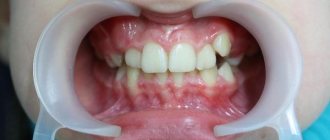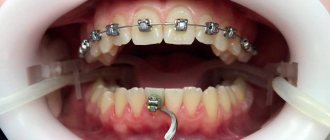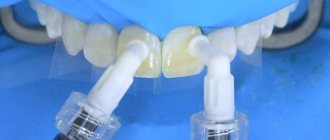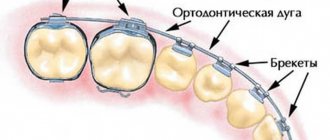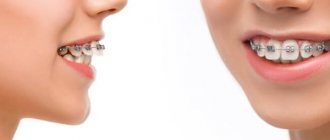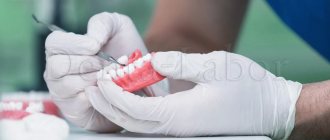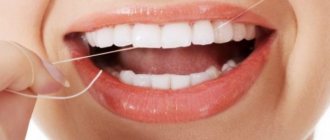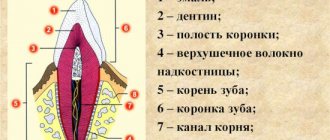Dental restoration or dental restoration is an artistic, direct and aesthetic restoration of the front teeth. Price for dental restoration in Moscow.
Each of us sooner or later faces a situation where teeth lose their aesthetic appeal. This may be due to carious tissue damage or deterioration in the quality of the old filling. In this case, dental units are completely or partially destroyed, their shape changes, and functionality deteriorates. As a result, a person loses one of the most important advantages - the ability to smile beautifully and communicate naturally with the interlocutor.
Today, the only correct solution is dental restoration. This procedure allows you to restore the functional characteristics and shape of damaged teeth using veneers or light-composite fillings.
Today, along with the term “artistic restoration of teeth,” consonant concepts (aesthetic and cosmetic restorations) are often found. However, in practice, they all have the same application and help restore the aesthetics of a damaged tooth.
In our Elident clinic, dental restoration is carried out by highly qualified specialists who master all the intricacies of this process, have the appropriate qualifications and solid experience. We carry out work of any complexity. Even if you need artistic restoration of your front teeth, you can count on an ideal result. Professional knowledge of all stages of dental restoration, an individual approach to each patient, the ability to work with modern materials and a flexible pricing policy - all this makes our services indispensable for patients and increases the chances of a successful outcome of the treatment process.
In this article we will talk about what aesthetic dental restoration is, consider the main methods and stages of its implementation, and provide detailed information on how much dental restoration costs in modern clinics in Moscow.
Free consultation
Our specialists will conduct a free consultation and select the best treatment option for you.
Sign up now! Online registration
+7 (495) 649-41-19
Content
1 What methods of dental restoration exist?
2 Stages of dental restoration
3 Dental restoration before and after photos
4 What influences the price of tooth restoration? 4.1 Complete crown correction
4.2 If half a tooth needs to be restored
4.3 Restoration of a chipped cutting edge of a front tooth
5 What are the disadvantages of artistic dental restoration?
6 Alternative to composite restoration
7 Prices for dental restoration
What methods of dental restoration exist?
Currently, artistic restoration of teeth is carried out using the following two methods:
- Direct dental restoration : carried out using light-curing fillings. Dental restoration using composite materials, which is carried out by a specialist in therapeutic dentistry;
- Dental restoration with veneers : This procedure involves a prosthetic specialist who prepares the tooth and makes an impression. Next, the process of creating the veneer itself is carried out, which involves the use of ceramic or zirconium material. The resulting plate is glued to the outer surface of the tooth. As a rule, veneers are used when restoration of the front teeth takes place. Despite their inflated cost, they have a number of advantages.
Stages of dental restoration
Next, we will talk in detail about how aesthetic restoration of anterior teeth is performed. An example will be a situation where a patient needs to restore a front tooth with old fillings that have lost their aesthetic appeal.
So, the restoration of the front teeth includes the following sequential stages:
- Preparing teeth. At this stage, dental units are cleaned of plaque, the shade of the destroyed tooth is determined and, based on it, the color of the photopolymer filling is selected.
- Administration of anesthetics (if necessary).
- Removal of tissues affected by caries . When there is a need to replace an old filling material that has lost its aesthetic qualities, it is drilled out.
- Elimination of excessive salivation . If previously cotton swabs were used for this purpose, now they use an innovative product - cofferdam. This is a material made of latex, which has special holes for teeth. Thanks to such a latex scarf, it is possible to qualitatively isolate the oral cavity from wet breath and saliva, which ensures a more reliable process for installing photopolymer fillings. If insulated incorrectly, dental restorations made with light-curing materials can quickly lose their properties. This will create an unwanted dark line between the tooth and the filling, or cause the composite material to fall out.
- Installation of the pin . It is used if there is massive destruction of the crown and there is no nerve in the tooth itself. In this case, tooth restoration is carried out on a pin, which plays the role of a strengthening element and prevents the restoration from falling out.
- Dental restoration with composite material . In order to give the tooth a natural appearance, a special technique for applying photopolymer mass is used. For this purpose, the light-curing material is applied in layers. It is thanks to the presence of layers with varying degrees of transparency and different color tones that it is possible to obtain a natural tooth shade.
- The final stage . The final processing of the dental unit is carried out, which includes grinding and polishing the filling material.
How restoration is carried out using the direct method - a step-by-step description of the process
To better imagine how the restoration procedure occurs, you need to understand how it is done using the direct method. If the indirect method involves the separate production of dentures using impressions and their subsequent fixation with adhesive or implant, then direct restoration is carried out directly in the patient’s mouth. The process includes the following steps:
- preparation of the oral cavity: removal of deposits, elimination of foci of inflammation and tissues destroyed by carious processes,
- selection of material by color and degree of transparency,
- administration of an anesthetic: anesthesia is used when large-scale work is to be done, including the installation of a pin or stump inlay - before this, the nerve is usually removed and the canals are filled,
- preparation: grinding the defect area, removing affected tissue, making a small indentation for better fixation of the composite material,
- isolation from saliva using a rubber dam: a small latex pad with a hole for the tooth is fixed in the working area,
- fixation of a pin or stump inlay in the canal: carried out when more than half is destroyed, after removal of the nerve, treatment and filling of the canals1,
- treatment of the surface of the support for better adhesion: with the help of special compounds it is dried and made slightly rough for reliable adhesion to the photopolymer,
- Layer-by-layer application of light-curing material: each subsequent layer is illuminated with a special UV lamp, under the influence of which it hardens. This technology makes it possible to achieve maximum strength of the composite fastening and accuracy in reproducing the anatomical shape.
In some cases, to correct the problem, it is necessary to take impressions.
Upon completion of all manipulations, the restored area is ground and polished. As for how long the entire procedure takes, everything is purely individual: from half an hour to hide a small chip to several hours to build up most of the damaged crown.
What influences the price of tooth restoration?
When a patient requires dental restoration, price is a key concept that influences his decision. Moreover, the cost often depends on the volume of tissue that needs to be restored, as well as on the material that is used in the process of restoration work. That is, if you are interested in how much it costs to restore a tooth, you should pay attention to whether it is partially restored or whether the crown is completely corrected.
Complete crown correction
Complete restoration of the tooth crown is carried out if the volume of destroyed tissue reaches more than half of the volume of the entire dental unit. In this case, tooth restoration takes place, the cost of which is influenced by the following factors:
- The cost of the anesthesia procedure: can reach 250-300 ₽;
- Elimination of salivation using coffee drum - can have a price of 300 ₽ and more;
- Using a sterile kit – from 150 ₽;
- If a tooth needs to be restored with a composite material, the price can be about 3-4 thousand rubles;
- Installation of a fiberglass pin – from 1,500 ₽. When using a high-quality reinforcing plate, it is possible to avoid sudden crown fractures associated with chewing hard foods. If restoration of anterior teeth is carried out, the price of the pin plays a decisive role. Although the metal material is much cheaper, fiberglass pins are more reliable and aesthetically pleasing. They do not give an undesirable bluish tint, have a transparency identical to natural teeth, are securely fixed in the dental canal and have good adhesion to composite fillings.
On average, in Moscow dental centers, a complete dental restoration costs 6-8 thousand rubles.
At the Elident clinic, a complete restoration of the crown part of a tooth with a light-curing material costs 6,500 rubles. We provide anesthesia at a price of 500 ₽, and applying an insulating pad costs 450 ₽. As for the payment for the fiberglass pin, we offer to install it for 1,600 ₽.
If you need to restore half a tooth
If the tooth was not completely destroyed and there is no need to use a pin made of fiberglass material, dental restoration will have a more affordable cost. Even taking into account all the associated costs, restoring half a tooth will cost you about 3,000 - 4,000 rubles.
Restoration of a chipped incisal edge of a front tooth
If you are restoring a small part of a tooth with a root present, you will only have to pay for the procedure for administering anesthetic agents and a composite filling. That is, restoration of chipped front teeth with filling material in mid-price dentistry will cost about 2 thousand rubles.
Indications and contraindications for the procedure
The choice of a specific restoration method directly depends on the nature of the damage and the extent of destruction of hard tissue. Appropriate specialist assistance is usually required in the following clinical cases:
- chips, cracks and other minor damage to the enamel,
- the presence of too large gaps between the crowns,
- damage to the cutting edge,
- destruction of half or most of the hard tissues,
- abnormal tooth sizes – too long or short,
- curved position of individual units with their slight deviation from the norm.
Chips and cracks in the teeth are an indication for restoration.
As for contraindications, much will again depend on the chosen restoration technique. Thus, installation of veneers, lumineers and extensions using the direct method - these procedures are not carried out if the patient suffers from bruxism, that is, unconscious clenching of the jaws during sleep, which leads to rapid abrasion of the enamel. These manipulations are contraindicated, including in cases of pathological abrasion, weakened and overly sensitive enamel (first you will need to undergo a course of remineralization and restoration), and insufficient oral care. It should also be taken into account that the shape and functionality can only be restored if there is no root by implanting an implant and installing a single prosthesis on it.
What are the disadvantages of artistic dental restoration?
Despite all the advantages that aesthetic dental restoration has, it can have several negative aspects. These include:
- Gradual loss of shine and natural shade. When composite dental restoration is carried out in any clinic in Moscow or any other city in the Russian Federation, no one will give you a guarantee of a prolonged result. The fact is that photopolymers over time can lose their original characteristics and darken, which leads to the loss of the external attractiveness of teeth and the need to replace the restoration material.
- Possibility of breakdown . If the volume of destroyed tissue exceeds more than 1/2 of the total volume of the tooth, and the dental nerve was previously removed, there is a high risk of crown breakage. Such dental units are very fragile, and breakage can occur when eating any hard food. However, restoring a broken tooth is not a solution to the problem. Experts recommend giving preference to installing an artificial crown.
How are teeth restored today? A complete overview of all modern techniques
If the integrity of the crown is compromised or even completely destroyed, the shape, aesthetics and functionality can be restored through restoration. Depending on the extent of the damage and the cause of its occurrence, a specific method of solving the problem is chosen: filling, installation of an inlay, direct extension with photopolymers, including on a pin or stump inlay, installation of veneers or lumineers, complete replacement of the visible part of the tooth with an artificial crown. As you can see, there are quite a lot of options, so later in this article we will understand what dental restoration is, what methods are used in dentistry today and how they differ from each other.
Our clinics
Clinic "Elident" on Varshavskaya
Varshavskoe highway, 75, bldg. 1, Moscow 117556
- Varshavskaya (500 m, closed until 2021)
- Nakhimovsky Prospekt (1,300 m)
Mon-Sat : 09:00-21:00; Sun : 09:00-19:00.
Online registration
+7 (495) 649-41-19
Elident Clinic in Annino
Varshavskoe highway, 154, building 1, Moscow 117405
- Annino (500 m)
- Academician Yangelya (700 m)
Mon-Sat : 09:00-21:00; Sun : 09:00-19:00.
Online registration
+7 (495) 649-41-19
Alternative to composite restoration
- Veneers. When dental restoration with photopolymers takes place, the price is not in doubt among patients and they immediately agree to the procedure. However, there are cases when a more preferable option for restoring teeth is installing veneers. The need to apply such reinforcing plates arises if tooth decay occurs only in the anterior part, and on the lingual side the tooth is only slightly damaged.
Moreover, it is better to install ceramic veneers, which do not lose their shine over time and do not fade. Despite all the advantages that such alternative dental restoration has, its price in Moscow remains high.
Even in budget dental clinics, installing veneers will cost you no less than 15,000 rubles. In high-level metropolitan dentistry, prices for veneers made of zirconium can reach 30-40 thousand rubles. However, this price includes all additional costs associated with anesthesia, x-rays, impressions and even a temporary plastic crown.
In our clinic, a ceramic veneer costs 25 thousand rubles, and the price of a zirconium veneer is 15 thousand rubles.
- Artificial crowns . Also, if there is significant destruction of the dental unit (more than 50%), the priority option is to install an artificial prosthesis. This is due to the fact that complete tooth restoration (from the root) has a cost similar to a metal-ceramic crown. However, in terms of strength and aesthetic parameters, the latter is considered a more preferable choice.
- Inlays . If necessary, a special restorative inlay can be used to restore chewing teeth. If such an inlay is made of ceramic material, it is more durable, stronger and more aesthetically pleasing than composite fillings.
Advantages and disadvantages
The restoration method using composite materials has its positive and negative sides. Advantages of the technique:
- low cost of the method compared to orthopedic;
- speed of implementation - the procedure is carried out during one visit to the dentist, it is also possible to do several teeth in one visit;
- minimal fabric trimming;
- if there is a chip or channel work is required, correction can be carried out without removing the entire restoration composition;
- effective in the presence of chips, cracks or gaps between teeth.

